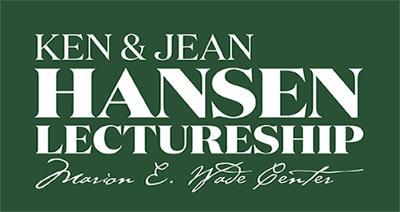
C.S. Lewis and the End of the World
 Dr. Aubrey Buster explores how C.S. Lewis’s fiction and theological writings serve to imagine the end of the world. Across three lectures, Dr. Buster analyzes Lewis’s use of and development of biblical images and language describing our various “ends” as well as how those images and language were received and re-shaped by Lewis’s own cultural context and literary influences. This series demonstrates how Lewis used the “envisioned ending” to respond to crises of his present, to give form to hope, and to inspire personal and communal action, a goal that he shares with the earliest authors of apocalyptic texts. The Hansen lectures are held in the Wade Center's Bakke Auditorium (351 E. Lincoln Ave.) at 7:00pm Central, and are free and open to the public.
Dr. Aubrey Buster explores how C.S. Lewis’s fiction and theological writings serve to imagine the end of the world. Across three lectures, Dr. Buster analyzes Lewis’s use of and development of biblical images and language describing our various “ends” as well as how those images and language were received and re-shaped by Lewis’s own cultural context and literary influences. This series demonstrates how Lewis used the “envisioned ending” to respond to crises of his present, to give form to hope, and to inspire personal and communal action, a goal that he shares with the earliest authors of apocalyptic texts. The Hansen lectures are held in the Wade Center's Bakke Auditorium (351 E. Lincoln Ave.) at 7:00pm Central, and are free and open to the public.
The lectures are recorded and uploaded to the Wade Center's YouTube channel.
Dr. Aubrey E. Buster ’09 is Associate Professor of Old Testament at Wheaton College, where she has taught since 2018. Dr. Buster holds a B.M. in Vocal Performance and English Literature and M.A. in Biblical Exegesis from Wheaton College, and a Ph.D. in Hebrew Bible from Emory University. Her research focuses on the Psalms, Chronicles, Ezra-Nehemiah, Daniel, and the Dead Sea Scrolls. She is the author of Remembering the Story of Israel: Historical Summaries and Memory Formation in Second Temple Judaism (Cambridge University Press, 2022) and co-author (with John H. Walton) of a forthcoming 2-volume commentary on the book of Daniel (Eerdmans, 2025-2026).
Lecture Dates and Titles

January 30, 2025 - "C.S. Lewis and the Apocalyptic Imagination"
Respondent: Danielle Corple, Associate Professor of Communication
Much of C.S. Lewis’s fiction deals with themes of endings and life beyond these endings. In the midst of contentious theories of doctrine about the end of the world, Lewis consistently chooses to reflect on “the end” through stories, stories that take place in alternate realms and imagined futures. In this way, Lewis joins a great tradition of theological thinkers extending back to the early Jewish and Christian authors who responded to the incoherence of their present experience through heavily symbolic narratives, divinely granted visions, and imagined dialogues between great figures of the past and supernatural beings. In this lecture, Dr. Buster traces the development of Lewis’s use of story to imagine distinctively Christian endings, including his development of biblical images, his interaction (often polemical) with contemporary biblical scholarship on “apocalypticism,” and his presentation of “story” as the proper form for imagining human ends.

February 27, 2025 - "'Here be Dragons': C.S. Lewis and the Construction of the Monstrous"
Respondent: John Walton, Professor of Old Testament Emeritus
Like generations of apocalyptic imaginaries before him, Lewis presents the social and religious threats of his age through the constructions of monsters. This lecture describes the function of the monstrous within Lewis’s visions of the end. The imagined monstrous also constructs as its counterpart imagined glory. Thus, our examination of the distorted, the vulgar, and the evil, provides a transition to the final lecture, which is an examination of the construction of Christian hope.

April 10, 2025 - "C.S. Lewis, the End(s) of Desire, and the Construction of Hope"
Respondent: Esau McCaulley, Jonathan Blanchard Associate Professor of New Testament and Public Theology
Lewis does not claim to be a theologian of eschatology, presenting or establishing a doctrine concerning the end of the world. Instead, he uses the “end times” scene, whether in an imagined post-war England, the fantasy world of Narnia, or in a dream vision to imagine either an (magnificently) ideal or (grotesquely) unideal future. In this lecture, I argue that both Lewis and the writers of ancient Jewish apocalypse used the construction of endings to shape communal desire and to motivate communal hope. Lewis’s repeated appeal to “longing” and “desire” as primary religious categories reveal an orientation to the end shared with the apocalyptic tradition. The apocalyptic scenario has been used to influence a community’s imagination of the ideal world, and to encourage its readers and hearers to act collectively towards this future of flourishing. I argue that Lewis uses stories imagining ends to re-orient his reader’s longings and desires in the present, a goal that he shares with the earliest authors of apocalyptic texts.
-
Connect with the Wade Center
-
By Mail:
Marion E. Wade Center, Wheaton College, 501 College Ave., Wheaton, IL 60187
See "Plan Your Visit" page for street address -
630.752.5908
wade@wheaton.edu - Instagram Facebook Youtube
